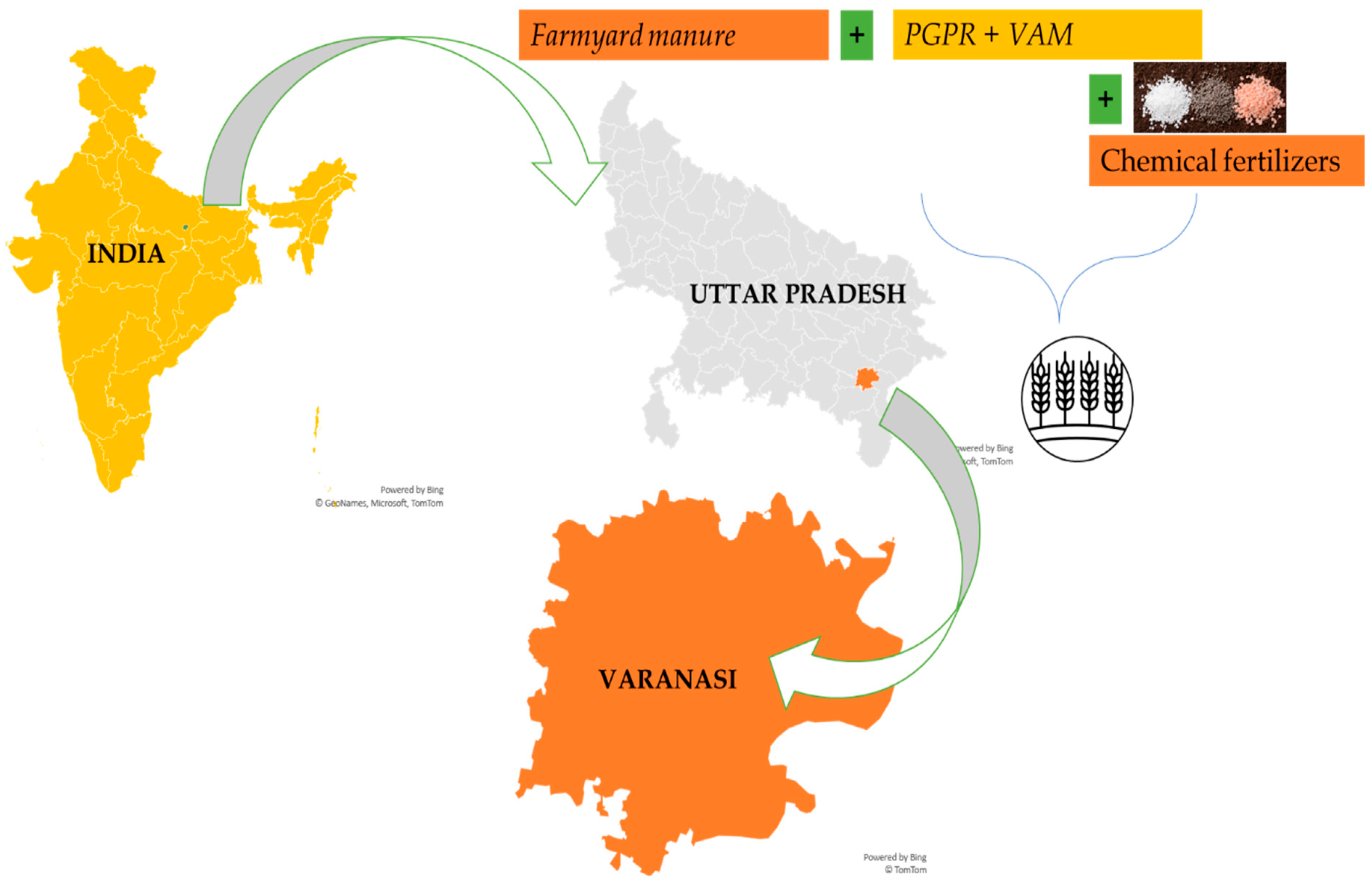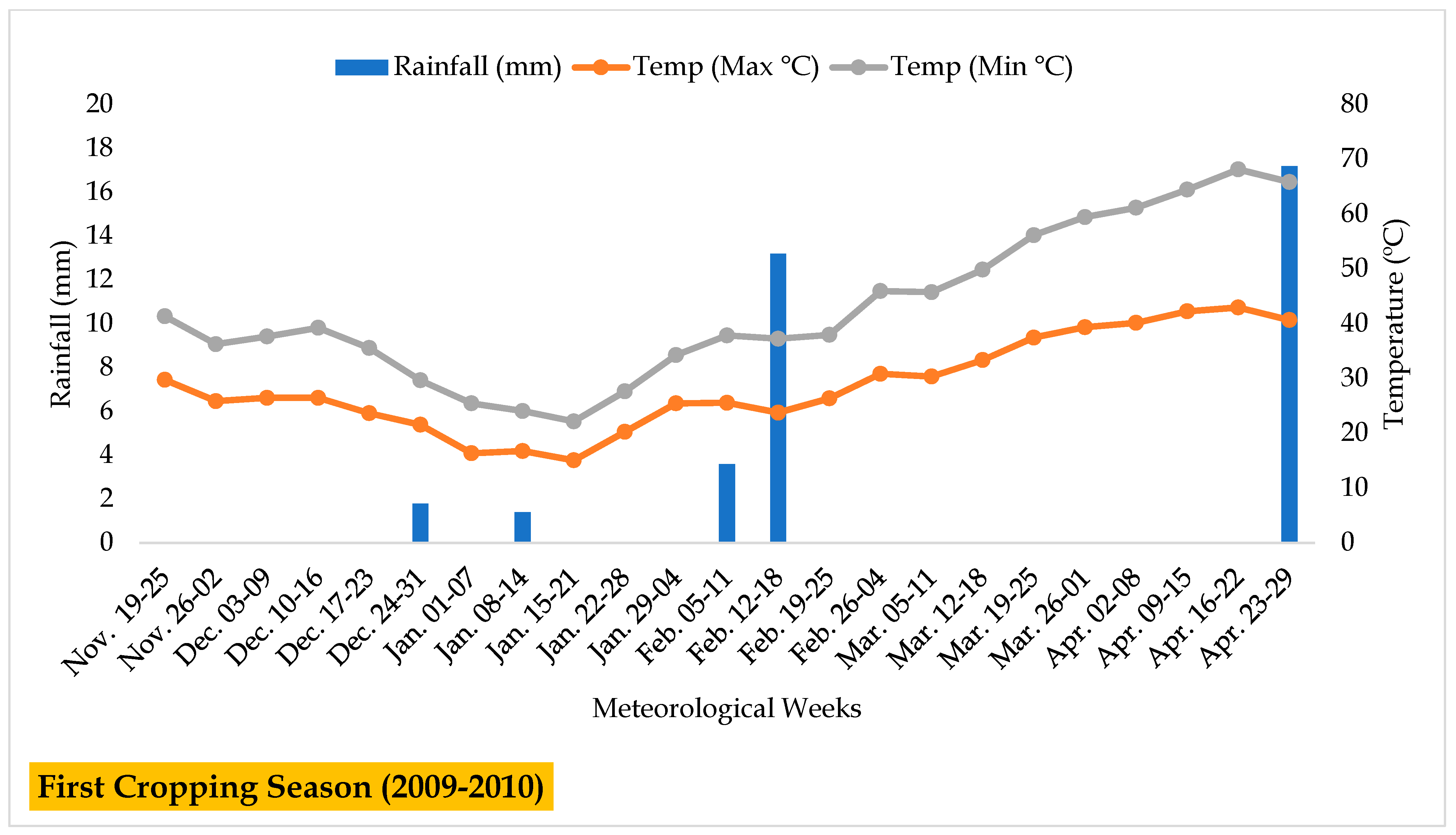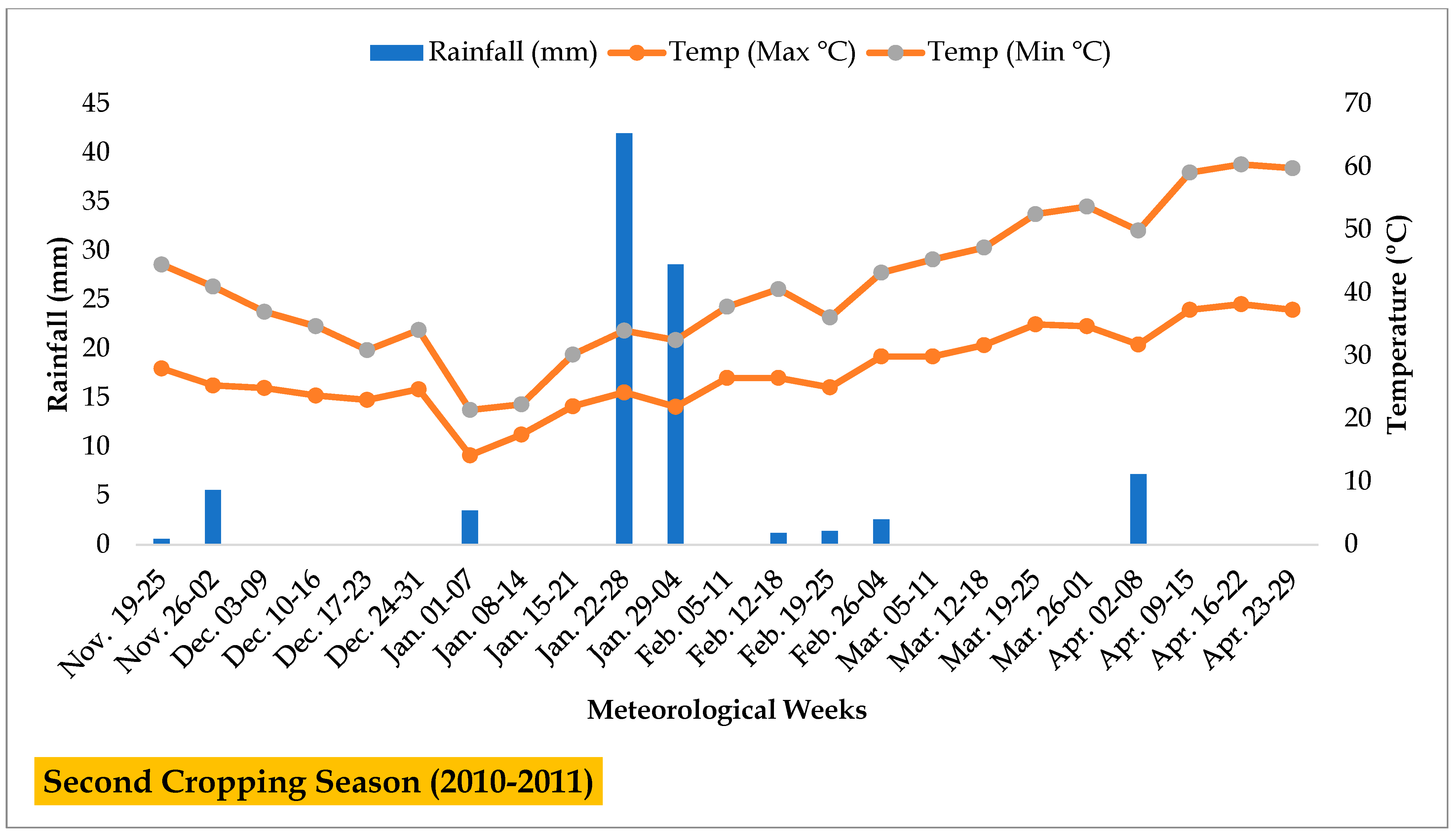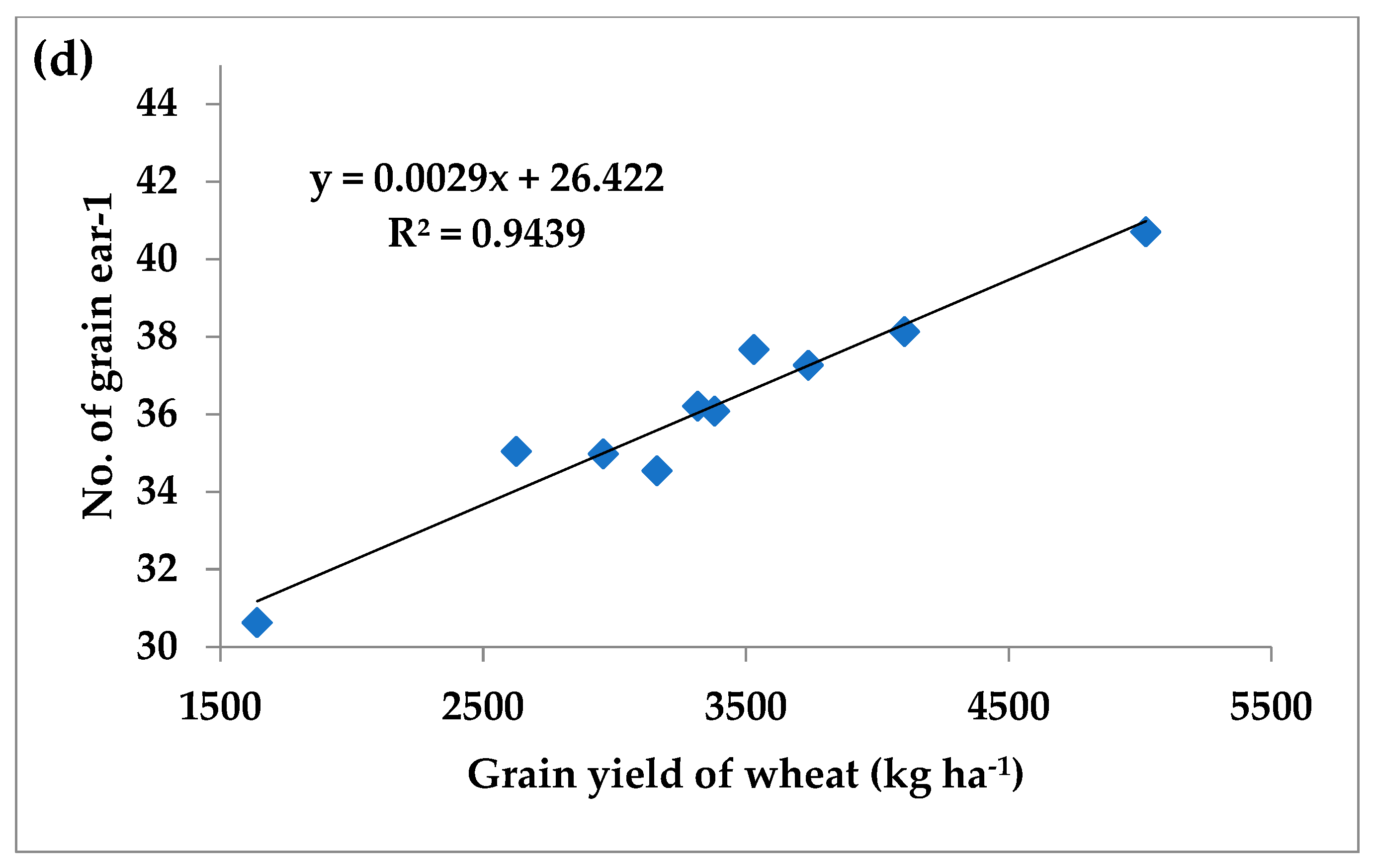Improved Nutrient Management Practices for Enhancing Productivity and Profitability of Wheat under Mid-Indo-Gangetic Plains of India
Abstract
:1. Introduction
2. Materials and Methods
2.1. Experimental Site
2.2. Climatic Conditions
2.3. Experimental Design and Treatment Details
2.4. Microbial Inoculants
2.5. Crop Cultivar
2.6. Crop Management Practices
2.7. Statistical Analysis
3. Results and Discussion
3.1. Effect on Growth Characters
3.2. Effect on Yield Attributes
3.3. Effect on Wheat Productivity
3.4. Effect on Interaction
3.5. Effect on Crop Profitability
3.6. Relationship between Grain Yield and Other Components
4. Conclusions
Author Contributions
Funding
Institutional Review Board Statement
Data Availability Statement
Acknowledgments
Conflicts of Interest
References
- Lu, C.; Tian, H. Global nitrogen and phosphorus fertilizer use for agriculture production in the past half century: Shifted hot spots and nutrient imbalance. Earth Syst. Sci. Data 2017, 9, 181–192. [Google Scholar] [CrossRef]
- Adhikary, S.; Khan, M.Z.; Arobe, S.; Dey, S.; Billah, S.M. Soil chemical analysis of Kazi and Kazi organic tea garden and compared to ordinary tea gardens of Bangladesh. Open J. Soil Sci. 2019, 9, 91–102. [Google Scholar] [CrossRef]
- Rakesh, S.; Sinha, A.K.; Sarkar, D.; Sahoo, S.; Roy, D. Key soil attributes as influenced by cropping systems in an Entisol of West Bengal, India. Clim. Chang. Environ. Sustain. 2020, 8, 226–232. [Google Scholar] [CrossRef]
- Aryal, J.P.; Sapkota, T.B.; Krupnik, T.J.; Rahut, D.B.; Jat, M.L.; Stirling, C.M. Factors affecting farmers’ use of organic and inorganic fertilizers in South Asia. Environ. Sci. Pollut. Res. 2021, 28, 51480–51496. [Google Scholar] [CrossRef]
- Sarkar, D.; Rakshit, A.; Al-Turki, A.I.; Sayyed, R.Z.; Datta, R. Connecting biopriming approach with integrated nutrient management for improved nutrient use efficiency in crop species. Agriculture 2021, 11, 372. [Google Scholar] [CrossRef]
- Rakesh, S.; Juttu, R.; Jogula, K.; Raju, B. Glauconite: An indigenous and alternative source of potassium fertilizer for sustainable agriculture. Int. J. Bioresour. Sci. 2020, 7, 17–19. [Google Scholar] [CrossRef]
- Sarkar, D.; Rakshit, A. Bio-priming in combination with mineral fertilizer improves nutritional quality and yield of red cabbage under Middle Gangetic Plains, India. Sci. Hortic. 2021, 283, 110075. [Google Scholar] [CrossRef]
- Dubey, P.K.; Singh, A.; Raghubanshi, A.; Abhilash, P.C. Steering the restoration of degraded agroecosystems during the United Nations Decade on Ecosystem Restoration. J. Environ. Manag. 2021, 280, 111798. [Google Scholar] [CrossRef]
- Parewa, H.P.; Meena, V.S.; Jain, L.K.; Choudhary, A. Sustainable crop production and soil health management through plant growth-promoting rhizobacteria. In Role of Rhizospheric Microbes in Soil; Meena, V., Ed.; Springer: Singapore, 2018; pp. 299–329. [Google Scholar]
- Bayu, W.; Rethman, N.F.G.; Hammes, P.S.; Alemu, G. Effect of farmyard manure and inorganic fertilizers on sorghum growth yield and nitrogen use in semi-arid area of Ethiopia. J. Plant Nutr. 2006, 29, 391–407. [Google Scholar] [CrossRef]
- Chahal, H.S.; Singh, S.; Dhillon, I.S.; Kaur, S. Effect of integrated nitrogen management on macronutrient availability under cauliflower (Brassica oleracea var. botrytis L.). Int. J. Curr. Microbiol. Appl. Sci. 2019, 8, 1623–1633. [Google Scholar] [CrossRef]
- Dubey, P.K.; Singh, A.; Chaurasia, R.; Pandey, K.K.; Bundela, A.K.; Singh, G.S.; Abhilash, P.C. Animal manures and plant residue-based amendments for sustainable rice-wheat production and soil fertility improvement in eastern Uttar Pradesh, North India. Ecol. Eng. 2022, 177, 106551. [Google Scholar] [CrossRef]
- Sarkar, D.; Dubey, P.K.; Chaurasiya, R.; Sankar, A.; Shikha; Chatterjee, N.; Ganguly, S.; Meena, V.S.; Meena, S.K.; Parewa, H.P.; et al. Organic interventions conferring stress tolerance and crop quality in agroecosystems during the UN Decade on Ecosystem Restoration. Land Degrad. Dev. 2021, 32, 4797–4816. [Google Scholar] [CrossRef]
- Tadesse, T.; Dechassa, N.; Bayu, W.; Gebeyehu, S. Effects of farmyard manure and inorganic fertilizer application on soil physico-chemical properties and nutrient balance in rain-fed lowland rice ecosystem. Am. J. Plant Sci. 2013, 4, 28313. [Google Scholar] [CrossRef]
- Ahmad, F.; Ahmad, I.; Khan, M.S. Screening of free-living rhizospheric bacteria for their multiple plant growth promoting activities. Microbiol. Res. 2008, 163, 173–181. [Google Scholar] [CrossRef] [PubMed]
- Aeron, A.; Khare, E.; Jha, C.K.; Meena, V.S.; Aziz, S.M.A.; Islam, M.T.; Kim, K.; Meena, S.K.; Pattanayak, A.; Rajashekara, H.; et al. Revisiting the plant growth-promoting rhizobacteria: Lessons from the past and objectives for the future. Arch. Microbiol. 2020, 202, 665–676. [Google Scholar] [CrossRef]
- Kumar, M.; Giri, V.P.; Pandey, S.; Gupta, A.; Patel, M.K.; Bajpai, A.B.; Jenkins, S.; Siddique, K.H.M. Plant-growth-promoting rhizobacteria emerging as an effective bioinoculant to improve the growth, production, and stress tolerance of vegetable crops. Int. J. Mol. Sci. 2021, 22, 12245. [Google Scholar] [CrossRef]
- Meena, V.S.; Zaid, A.; Maurya, B.R.; Meena, S.K.; Bahadur, I.; Saha, M.; Kumar, A.; Verma, R.; Wani, S.H. Evaluation of potassium solubilizing rhizobacteria (KSR): Enhancing K-bioavailability and optimizing K-fertilization of maize plants under Indo-Gangetic Plains of India. Environ. Sci. Pollut. Res. 2018, 25, 36412–36424. [Google Scholar] [CrossRef]
- Kumar, A.; Patel, J.S.; Meena, V.S.; Ramteke, P.W. Plant growth promoting rhizobacteria: Strategies to improve abiotic stresses under sustainable agriculture. J. Plant Nutr. 2019, 42, 1402–1415. [Google Scholar] [CrossRef]
- Sarkar, D.; Sankar, A.; Devika, O.S.; Singh, S.; Shikha Parihar, M.; Rakshit, A.; Sayyed, R.Z.; Gafur, A.; Ansari, M.J.; Danish, S.; et al. Optimizing nutrient use efficiency, productivity, energetics, and economics of red cabbage following mineral fertilization and biopriming with compatible rhizosphere microbes. Sci. Rep. 2021, 11, 15680. [Google Scholar] [CrossRef]
- Vij, S.; Sharma, N.; Sharma, M.; Mohanta, T.K.; Kaushik, P. Application of Trichoderma viride and Pseudomonas fluorescens to cabbage (Brassica oleracea L.) improves both its seedling quality and field performance. Sustainability 2022, 14, 7583. [Google Scholar] [CrossRef]
- Souza, R.; Ambrosini, A.; Passaglia, L.M. Plant growth-promoting bacteria as inoculants in agricultural soils. Genet. Mol. Biol. 2015, 38, 401–419. [Google Scholar] [CrossRef] [PubMed]
- Rozier, C.; Hamzaoui, J.; Lemoine, D.; Czarnes, S.; Legendre, L. Field-based assessment of the mechanism of maize yield enhancement by Azospirillum lipoferum CRT1. Sci. Rep. 2017, 7, 7416. [Google Scholar] [CrossRef] [PubMed]
- Renoud, S.; Vacheron, J.; Abrouk, D.; Prigent-Combaret, C.; Legendre, L.; Muller, D.; Moënne-Loccoz, Y. Field site-specific effects of an Azospirillum seed inoculant on key microbial functional groups in the rhizosphere. Front. Microbiol. 2022, 12, 760512. [Google Scholar] [CrossRef] [PubMed]
- Vessey, J.K. Plant growth promoting rhizobacteria as biofertilizers. Plant Soil 2003, 255, 571–586. [Google Scholar] [CrossRef]
- Dong, L.; Li, Y.; Xu, J.; Yang, J.; Wei, G.; Shen, L.; Ding, W.; Chen, S. Biofertilizers regulate the soil microbial community and enhance Panax ginseng yields. Chin. Med. 2019, 14, 20. [Google Scholar] [CrossRef]
- Anli, M.; Baslam, M.; Tahiri, A.; Raklami, A.; Symanczik, S.; Boutasknit, A.; Ait-El-Mokhtar, M.; Ben-Laouane, R.; Toubali, S.; Ait Rahou, Y.; et al. Biofertilizers as strategies to improve photosynthetic apparatus, growth, and drought stress tolerance in the date palm. Front. Plant Sci. 2020, 11, 516818. [Google Scholar] [CrossRef]
- Atieno, M.; Herrmann, L.; Nguyen, H.T.; Phan, H.T.; Nguyen, N.K.; Srean, P.; Than, M.M.; Zhiyong, R.; Tittabutr, P.; Shutsrirung, A.; et al. Assessment of biofertilizer use for sustainable agriculture in the Great Mekong Region. J. Environ. Manag. 2020, 275, 111300. [Google Scholar] [CrossRef]
- Sarkar, D.; Rakshit, A.; Parewa, H.P.; Danish, S.; Alfarraj, S.; Datta, R. Biopriming with compatible rhizospheric microbes enhances growth and micronutrient uptake of red cabbage. Land 2022, 11, 536. [Google Scholar] [CrossRef]
- Panday, S.C.; Choudhary, M.; Singh, S.; Meena, V.S.; Mahanta, D.; Yadav, R.P.; Pattanayak, A.; Bisht, J.K. Increasing farmer’s income and water use efficiency as affected by long-term fertilization under a rainfed and supplementary irrigation in a soybean-wheat cropping system of Indian mid-Himalaya. Field Crops Res. 2018, 219, 214–221. [Google Scholar] [CrossRef]
- Singh, A.; Sravan, U.S.; Kumar, S.; Singh, S.P. Impact of fertility levels and bio-fertilizers on growth, yield and economics of basmati Rice. Int. J. Curr. Microbiol. Appl. Sci. 2017, 6, 1471–1476. [Google Scholar]
- Thakur, J.; Kumar, P.M. Studies on conjoint application of nutrient sources and PGPR on growth, yield, quality, and economics of cauliflower (Brassica oleracea var. botrytis L.). J. Plant Nutr. 2018, 41, 1862–1867. [Google Scholar] [CrossRef]
- Khosravi, A.; Zarei, M.; Ronaghi, A. Effect of PGPR, phosphate sources and vermicompost on growth and nutrients uptake by lettuce in a calcareous soil. J. Plant Nutr. 2018, 41, 80–89. [Google Scholar] [CrossRef]
- Sarkar, D.; Rakesh, S.; Sinha, A.K.; Mukhopadhyay, P.; Singh, Y.V. Effect of phosphate solubilizing bacteria on phosphatase activities, yield and phosphorus nutrition of wheat in an acidic Entisol. J. Indian Soc. Soil Sci. 2021, 69, 429–439. [Google Scholar] [CrossRef]
- Tahiri, A.I.; Meddich, A.; Raklami, A.; Alahmad, A.; Bechtaoui, N.; Anli, M.; Göttfert, M.; Heulin, T.; Achouak, W.; Oufdou, K. Assessing the potential role of compost, PGPR, and AMF in improving tomato plant growth, yield, fruit quality, and water stress tolerance. J. Soil Sci. Plant Nutr. 2022, 22, 743–764. [Google Scholar] [CrossRef]
- Parewa, H.P.; Rakshit, A.; Yadav, J. A Review on the Effect of Integrated Nutrient Management on Soil Properties and Yield of Wheat (Triticum aestivum L.). Indian J. Plant Soil 2015, 2, 119–124. [Google Scholar]
- Selim, M.M. Introduction to the integrated nutrient management strategies and their contribution to yield and soil properties. Int. J. Agron. 2020, 2020, 2821678. [Google Scholar] [CrossRef]
- Gomez, K.A.; Gomez, A.A. Statistical Procedures for Agricultural Research, 2nd ed.; John Wiley and Sons, Inc.: London, UK, 1984; pp. 13–175. [Google Scholar]
- Malghani, A.L.; Malik, A.U.; Sattarb, A.; Hussaina, F.; Abbasc, G.; Hussai, J. Response of growth and yield of wheat to NPK fertilizer. Sci. Int. 2010, 24, 185–189. [Google Scholar]
- Abd El-Razek, U.A.; El-Sheshtaway, A.A. Response of some wheat varieties to Bio and mineral nitrogen fertilizers. Asian J. Crop Sci. 2013, 5, 200–208. [Google Scholar] [CrossRef]
- Lavakush Yadav, J.; Verma, J.P.; Jaiswal, D.K.; Kumar, A. Evaluation of PGPR and different concentration of phosphorus level on plant growth, yield and nutrient content of rice (Oryza sativa). Ecol. Eng. 2014, 62, 123–128. [Google Scholar] [CrossRef]
- Agamy, R.A.; Mohamed, G.F.; Rady, M.M. Influence of the application of fertilizer type on growth, yield, anatomical structure and some chemical components of wheat (Triticum aestivum L.) grown in newly reclaimed soil. Aust. J. Basic Appl. Sci. 2012, 6, 561–570. [Google Scholar]
- Devi, K.N.; Singh, T.B.; Athokpam, H.S.; Singh, N.B.; Shamurailatpam, D. Influence of inorganic, biological and organic manures on nodulation and yield of soybean (Glycine max Merril L.) and soil properties. Aust. J. Crop Sci. 2013, 7, 1407–1415. [Google Scholar]
- Puli, M.R.; Prasad, P.R.K.; Babu, P.R.; Jayalakshmi, M.; Burla, S.R. Effect of organic and inorganic sources of nutrients on rice crop. Oryza 2016, 53, 151–159. [Google Scholar]
- Singh, B.; Singh, A.P. Response of wheat (Triticum aestivum L.) to FYM and phosphorus application in alluvial soil. Int. J. Curr. Microbiol. Appl. Sci. 2018, 7, 418–423. [Google Scholar] [CrossRef]
- Kavinder, V.S.; Hooda, Y.P.; Malik, D.; Kavita, H. Effect of farm yard manure and nitrogen application on growth and productivity of wheat under long term experimental conditions. Curr. J. Appl. Sci. Technol. 2019, 35, 1–7. [Google Scholar]
- Ramhari Ghosh, A.K.; Kurrey, P.M. Effect of pgpr and organic manure and plant growth, yield attributes in wheat under organic farming system Triticum aestivum L. Agric. Biol. Res. 2021, 37, 163–170. [Google Scholar]
- Burd, G.I.; Dixon, D.G.; Glick, B.R. PGPR that decrease heavy metal toxicity in plants. Can. J. Microbiol. 2000, 3, 237–245. [Google Scholar] [CrossRef]
- Tulasa, R.; Mir, M. Effect of integrated nutrient management on yield and yield-attributing characters of wheat (Triticum aestivum). Indian J. Agron. 2006, 51, 189–192. [Google Scholar]
- Jat, M.K.; Purohit, H.S.; Bahadur, S.; Garhwal, R.S.; Choudhary, M. Effect of integrated nutrient management on yield and nutrient uptake in sorghum (Sorghum bicolor). Indian J. Agron. 2013, 58, 543–547. [Google Scholar]
- Singh, R.; Agarwal, S.K. Growth and yield of wheat (Triticum aestivum) as influenced by levels of farmyard manure and nitrogen. Indian J. Agron. 2001, 46, 462–467. [Google Scholar]
- Parewa, H.P.; Moola Ram Jain, L.K.; Choudhary, A.; Ratnoo, S.D. Impact of organic nutrient management practices on yield attributes, yield and economics of wheat (Triticum aestivum L.). Int. J. Bio-Resour. Stress Manag. 2019, 10, 257–260. [Google Scholar] [CrossRef]
- Nath, D.; Meena, V.S. Mycorrhizae: A potential microorganism and its implication in agriculture. In Role of Rhizospheric Microbes in Soil; Meena, V.S., Ed.; Springer: Singapore, 2018; pp. 251–276. [Google Scholar]
- Gupta, G.; Dhar, S.; Dass, A.; Sharma, V.K.; Shukla, L.; Singh, R.; Kumar, A.; Kumar, A.; Jinger, D.; Kumar, D.; et al. Assessment of bio-inoculants-mediated nutrient management in terms of productivity, profitability and nutrient harvest index of pigeon pea–wheat cropping system in India. J. Plant Nutr. 2020, 43, 2911–2928. [Google Scholar] [CrossRef]
- Bangre, J.; Dwivedi, A.K.; Mohanty, M.; Dwivedi, B.S.; Dwivedi, S.K. Wheat Physiological Parameters under Long Term Fertilizer and Manure Application in a Vertisol. Int. J. Curr. Microbiol. Appl. Sci. 2020, 9, 3511–3520. [Google Scholar] [CrossRef]
- Anisuzzaman, M.; Rafii, M.Y.; Ramlee, S.I.; Jaafar, N.M.; Ikbal, M.F.; Haque, M.A. The Nutrient Content, Growth, Yield, and Yield Attribute Traits of Rice (Oryza sativa L.) Genotypes as Influenced by Organic Fertilizer in Malaysia. Sustainability 2022, 14, 5692. [Google Scholar] [CrossRef]
- Reena Pandey, S.B.; Tiwari, D.D.; Nigam, R.C.; Singh, A.K.; Kumar, S. Effect of Integrated Nutrient Management on Yield and Nutrients Uptake of wheat and Soil Health. Int. Arch. Appl. Sci. Technol. 2017, 8, 25–28. [Google Scholar]
- Rathi, D.; Sharma, M.K.; Isha Dahiya, G. Yield and Yield Attributes of Wheat Crop Response to FYM and Fertilizers Application: A Review. Int. J. Pure Appl. Biosci. 2020, 8, 308–312. [Google Scholar] [CrossRef]
- Tejalben, P.; Patel, K.C.; Patel, V.N. Effect of integrated nutrient management on yield attributes and yield of wheat (Triticum aestivum L.). Int. J. Chem. Stud. 2017, 5, 1366–1369. [Google Scholar]
- Thakur, M.; Agrawal, H.P. Effect of bio-inoculant, organic manure and chemical fertilizer on growth and yield of wheat (Triticum aestivum L.). Int. J. Chem. Stud. 2020, 8, 2293–2296. [Google Scholar] [CrossRef]
- Singh, N.; Pandey, S.B.; Ranjan, R.; Verma, A.K.; Pathak, R.K.; Dubey, S.; Rajput, N.; Singh, R. Integrated use of organic (FYM), inorganic and biofertilizer (PSB) on productivity, nutrient uptake of wheat and soil properties. Pharma Innov. J. 2020, 9, 345–347. [Google Scholar]
- Mohamed, M.F.; Thalooth, A.T.; Elewa, T.A.; Ahmed, A.G. Yield and nutrient status of wheat plants (Triticum aestivum) as affected by sludge, compost, and biofertilizers under newly reclaimed soil. Bull. Natl. Res. Cent. 2019, 43, 31. [Google Scholar] [CrossRef]
- Apori, S.O.; Byalebeka, J.; Murongo, M.; Ssekandi, J.; Noel, G.L. Effect of co-applied corncob biochar with farmyard manure and NPK fertilizer on tropical soil. Resour. Environ. Sustain. 2021, 5, 100034. [Google Scholar] [CrossRef]
- Ullasa, M.Y.; Girijesh, G.K.; Kumar, M.D. Effect of fertilizer levels and foliar nutrition on yield, nutrient uptake and economics of maize (Zea mays L.). Green Farming 2016, 7, 1383–1388. [Google Scholar]






| Field Operation/Activities | First Cropping Season (2009–10) | Second Cropping Season (2010–11) |
|---|---|---|
| Design | Double split plot design | |
| Layout | 13-11-2009 | 15-11-2010 |
| Incorporation of FYM | 13-11-2009 | 15-11-2010 |
| Sowing | 11-12-09 | 08-12-10 |
| Seed rate (kg ha−1) | 120 | |
| Row spacing (cm) | 22.5 | |
| Variety | HUW-234 | |
| Fertilizer management | ||
| Fertilizer application (RDF of N-P-K = 120-60-60 kg ha−1) |
| |
| Water management | ||
| 01-01-10 | 29-12-10 |
| 09-02-10 | 06-02-11 |
| 11-03-10 | 08-03-11 |
| Weed management | ||
| Weeding type | Manual weeding | |
| Weeding date | 15-01-10 | 12-01-11 |
| Harvesting | 15-04-10 | 07-04-11 |
| Threshing and winnowing | 26-04-2010 | 20-04-2011 |
| Treatments | Plant Height (cm) | Number of Tillers per Meter Row | Number of Ear Head per Meter Row | No. of Grain per Ear | Ear Head Length (cm) | Test Weight (g) | Grain Yield (q ha−1) | Straw Yield (q ha−1) | Harvest Index (%) |
|---|---|---|---|---|---|---|---|---|---|
| Fertility levels | |||||||||
| Control | 73.75 | 75.13 | 63.67 | 30.63 | 6.89 | 35.26 | 16.40 | 25.52 | 39.04 |
| NPK50% | 80.57 | 90.92 | 75.50 | 35.04 | 7.86 | 39.59 | 26.27 | 40.33 | 39.26 |
| NPK75% | 97.46 | 101.42 | 85.38 | 38.13 | 8.32 | 41.59 | 41.03 | 59.17 | 40.84 |
| NPK100% | 102.04 | 104.71 | 95.71 | 40.71 | 8.82 | 42.33 | 50.22 | 70.68 | 41.55 |
| SE m± | 0.369 | 0.310 | 0.591 | 0.33 | 0.042 | 0.048 | 0.164 | 0.421 | 0.237 |
| CD 5% | 1.274 | 1.071 | 2.038 | 1.136 | 0.146 | 0.166 | 0.565 | 1.453 | 0.818 |
| FYM levels (t ha−1) | |||||||||
| FYM0 | 85.27 | 89.44 | 78.00 | 34.98 | 7.70 | 39.01 | 29.58 | 44.18 | 39.56 |
| FYM10 | 91.64 | 96.65 | 82.13 | 37.27 | 8.25 | 40.37 | 37.37 | 53.67 | 40.79 |
| SE m± | 0.223 | 0.289 | 0.406 | 0.195 | 0.029 | 0.050 | 0.132 | 0.169 | 0.110 |
| CD 5% | 0.726 | 0.940 | 1.321 | 0.635 | 0.093 | 0.163 | 0.431 | 0.551 | 0.359 |
| PGPR | |||||||||
| No-inoculation | 86.90 | 87.92 | 75.75 | 34.54 | 7.73 | 39.57 | 31.62 | 46.89 | 39.87 |
| PGPR | 88.29 | 94.58 | 80.33 | 36.08 | 7.98 | 39.74 | 33.81 | 48.96 | 40.38 |
| VAM | 88.74 | 92.54 | 80.42 | 36.21 | 8.01 | 39.64 | 33.16 | 48.46 | 40.15 |
| PGPR + VAM | 89.88 | 97.13 | 83.75 | 37.67 | 8.16 | 39.83 | 35.31 | 51.40 | 40.29 |
| SE m± | 0.355 | 0.267 | 0.586 | 0.197 | 0.037 | 0.083 | 0.147 | 0.158 | 0.118 |
| CD 5% | 1.010 | 0.760 | 1.666 | 0.559 | 0.106 | NS | 0.417 | 0.450 | 0.334 |
| Treatments | Plant Height | Number of Tillers per m Row | Ear Head Length (cm) | |||||||||
|---|---|---|---|---|---|---|---|---|---|---|---|---|
| Control | NPK50% | NPK75% | NPK100% | Control | NPK50% | NPK75% | NPK100% | Control | NPK50% | NPK75% | NPK100% | |
| FYM0 | 71.99 | 77.46 | 92.45 | 99.18 | 72.33 | 87.50 | 98.17 | 99.75 | 6.42 | 7.68 | 8.28 | 8.41 |
| FYM10 | 75.51 | 83.68 | 102.47 | 104.90 | 77.92 | 94.33 | 104.67 | 109.67 | 7.36 | 8.04 | 8.36 | 9.23 |
| SEm± = 0.446, CD (5%) = 1.452 | SEm± = 0.577, CD (5%) = 1.881 | SEm± = 0.186, CD (5%) = 0.186 | ||||||||||
| Treatments | Test Weight (g) | Grain Yield (q ha−1) | Straw Yield (q ha−1) | |||||||||
|---|---|---|---|---|---|---|---|---|---|---|---|---|
| Control | NPK50% | NPK75% | NPK100% | Control | NPK50% | NPK75% | NPK100% | Control | NPK50% | NPK75% | NPK100% | |
| FYM0 | 34.46 | 38.83 | 41.26 | 41.50 | 13.93 | 21.65 | 35.79 | 46.95 | 22.30 | 35.25 | 54.06 | 65.11 |
| FYM10 | 36.06 | 40.34 | 41.92 | 43.16 | 18.87 | 30.89 | 46.26 | 53.48 | 28.74 | 45.41 | 64.29 | 76.25 |
| SEm± = 0.100, CD (5%) = 0.327 | SEm± = 0.264, CD (5%) = 0.861 | SEm± = 0.338, CD (5%) = 1.101 | ||||||||||
| Treatments | Number of Ear Head per Meter Row | Straw Yield (q ha−1) | ||||||
|---|---|---|---|---|---|---|---|---|
| No-Inoculation | PGPR | VAM | PGPR + VAM | No-Inoculation | PGPR | VAM | PGPR + VAM | |
| FYM0 | 75.17 | 78.00 | 77.67 | 81.17 | 41.63 | 44.50 | 44.12 | 46.47 |
| FYM10 | 76.33 | 82.67 | 83.17 | 86.33 | 52.15 | 53.42 | 52.79 | 56.33 |
| SEm± = 0.828, CD (5%) = 2.356 | SEm± = 0.224, CD (5%) = 0.637 | |||||||
| Treatments | Grain Yield (q ha−1) | Straw Yield (q ha−1) | ||||||
|---|---|---|---|---|---|---|---|---|
| Control | NPK50% | NPK75% | NPK100% | Control | NPK50% | NPK75% | NPK100% | |
| No-inoculation | 15.68 | 24.23 | 39.58 | 47.01 | 24.69 | 38.27 | 56.77 | 67.85 |
| PGPR | 16.41 | 26.65 | 41.34 | 50.83 | 25.34 | 40.38 | 59.35 | 70.77 |
| VAM | 16.12 | 26.19 | 40.36 | 49.99 | 25.27 | 39.92 | 58.89 | 69.75 |
| PGPR + VAM | 17.40 | 28.00 | 42.82 | 53.‘04 | 26.79 | 42.76 | 61.69 | 74.37 |
| SEm± = 0.293, CD (5%) = 0.834 | SEm± = 0.317, CD (5%) = 0.900 | |||||||
| Treatments | Gross Return (₹ ha−1) | Cost of Cultivation (₹ ha−1) | Net Return (₹ ha−1) | Benefit: Cost |
|---|---|---|---|---|
| Fertility levels | ||||
| Control | 28,154.67 | 17,655 | 10,499.67 | 0.59 |
| NPK50% | 44,928.67 | 20,808 | 24,120.46 | 1.15 |
| NPK75% | 69,028.71 | 22,385 | 46,643.71 | 2.07 |
| NPK100% | 83,969.29 | 23,961 | 60,007.83 | 2.50 |
| SEm± | 216.21 | 216.24 | 0.010 | |
| CD 5% | 746.23 | 746.32 | 0.035 | |
| FYM levels (t ha−1) | ||||
| FYM0 | 50,225.48 | 19,952 | 30,273.08 | 1.43 |
| FYM10 | 62,815.19 | 22,452 | 40,362.75 | 1.72 |
| SE m± | 172.15 | 172.17 | 0.007 | |
| CD 5% | 560.74 | 560.80 | 0.024 | |
| PGPR | ||||
| No inoculation | 53,593.13 | 21,152 | 32,440.67 | 145 |
| PGPR | 56,940.58 | 21,212 | 35,728.29 | 1.59 |
| VAM | 55,988.58 | 21,192 | 34,796.21 | 1.55 |
| PGPR + VAM | 59,559.04 | 21,252 | 38,306.50 | 1.71 |
| SEm± | 192.74 | 192.72 | 0.008 | |
| CD 5% | 548.17 | 548.12 | 0.024 | |
| Treatments | Control | NPK50% | NPK75% | NPK100% | ||||
|---|---|---|---|---|---|---|---|---|
| FYM0 | FYM10 | FYM0 | FYM10 | FYM0 | FYM10 | FYM0 | FYM10 | |
| No inoculation | 0.39 | 0.65 | 0.80 | 1.19 | 1.73 | 2.19 | 2.27 | 2.46 |
| PGPR | 0.45 | 0.70 | 0.94 | 1.39 | 1.93 | 2.25 | 2.48 | 2.58 |
| VAM | 0.45 | 0.66 | 0.92 | 1.35 | 1.83 | 2.23 | 2.43 | 2.52 |
| PGPR + VAM | 0.56 | 0.78 | 1.02 | 1.52 | 2.03 | 2.37 | 2.58 | 2.78 |
| SEm± = 0.024, CD (5%) = 0.068 | ||||||||
Publisher’s Note: MDPI stays neutral with regard to jurisdictional claims in published maps and institutional affiliations. |
© 2022 by the authors. Licensee MDPI, Basel, Switzerland. This article is an open access article distributed under the terms and conditions of the Creative Commons Attribution (CC BY) license (https://creativecommons.org/licenses/by/4.0/).
Share and Cite
Parewa, H.P.; Yadav, J.; Meena, V.S.; Sarkar, D.; Meena, S.K.; Rakshit, A.; Datta, R. Improved Nutrient Management Practices for Enhancing Productivity and Profitability of Wheat under Mid-Indo-Gangetic Plains of India. Agriculture 2022, 12, 1472. https://doi.org/10.3390/agriculture12091472
Parewa HP, Yadav J, Meena VS, Sarkar D, Meena SK, Rakshit A, Datta R. Improved Nutrient Management Practices for Enhancing Productivity and Profitability of Wheat under Mid-Indo-Gangetic Plains of India. Agriculture. 2022; 12(9):1472. https://doi.org/10.3390/agriculture12091472
Chicago/Turabian StyleParewa, Hanuman Prasad, Janardan Yadav, Vijay Singh Meena, Deepranjan Sarkar, Sunita Kumari Meena, Amitava Rakshit, and Rahul Datta. 2022. "Improved Nutrient Management Practices for Enhancing Productivity and Profitability of Wheat under Mid-Indo-Gangetic Plains of India" Agriculture 12, no. 9: 1472. https://doi.org/10.3390/agriculture12091472
APA StyleParewa, H. P., Yadav, J., Meena, V. S., Sarkar, D., Meena, S. K., Rakshit, A., & Datta, R. (2022). Improved Nutrient Management Practices for Enhancing Productivity and Profitability of Wheat under Mid-Indo-Gangetic Plains of India. Agriculture, 12(9), 1472. https://doi.org/10.3390/agriculture12091472









